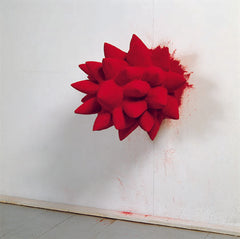By Lyn French, A Space Director

1000 Names (1982), Anish Kapoor
In previous blog posts we have talked about how contemporary images support the technique of free association. Here Lyn explores free association further and illustrate ways in which our Emotional Learning Cards can act as an important stimulus for this activity.
Free association is a technique originally devised by Sigmund Freud. In free association the client is invited to let their mind roam without censorship or structure and to naturally make random connections between thoughts; creating a narrative or stream of consciousness. When a client is fully relaxed and able to truly “freely” associate, it is possible to identify patterns of thought, impulses and fears which can be further explored in later sessions. Free association also has a purging effect of enabling the client to look at the world from a number of different perspectives without recourse to labelling any one view as right or wrong or necessarily positive or negative.
Encouraging a client to free associate can be challenging. He or she must be both fully relaxed but also alert to the world around them. Often a stimulus is needed in order to encourage this state- a visual reference which intrigues the client and begins an associated stream of words and thoughts.
Our Emotional Learning Cards, which feature carefully selected images of contemporary art, are specifically designed to encourage free association. In creating the cards, each image has been analysed and discussed for their suitability as a stimuli for this technique. Is the image too literal to encourage a diversity of responses? Is it too vague and ambient to create a narrative? Is the image overly negative or positive in its feel and look? The result is, we hope, a selection of 40 images across the two sets of cards that inspire, stimulate and intrigue the client, and from which a deep and personal conversation can emerge.
For example, let us consider a session which focuses on Anish Kapoor’s 1000 Names (1982) from the set of entitled ‘What do you feel?’ Clients freely associating might see the image as an exotic plant flowering in a sterile environment or, conversely, as a dangerous missile breaking through a wall, two very different interpretations and neither one more ‘accurate’ than the other. Each speaks of emotional undercurrents and can provide a useful platform for an exploration of general experiences common to us all. The client could be invited to imagine what kinds of situations might result in having to survive in an unresponsive or unsympathetic environment. This might trigger thoughts about not fitting into a family or a social group or feeling out of kilter with the so-called norm or being overlooked or unappreciated. Or considering the second, more threatening association, you might suggest your client gives some examples of when someone might feel a sense of imminent danger that threatens to erupt unpredictably.
You may need to role model free association if your client finds it hard to see anything in an image. You can break the process down, asking, for example, what your client associates with the colour red and then consider the shape itself- does it look spiky or soft? What does it remind you of? Does it look like its breaking through the wall or just hanging there like a startlingly unusual flower? Does it look ‘alien’ or foreign or exotic? And so on.
Such conversations can be used to move clients towards more personal reflections. This can be achieved by asking ‘when have you felt this way?’ The card itself provides a safety net; if the conversation feels too exposing for the client, you can take a step back and return to it saying ‘perhaps the artist knows everyone has experiences of feeling alien or foreign and tried to capture this.’
Of course free association is not only an exercise to be used in the therapy session. There are many games that children and young people enjoy playing which are in many ways similar to the act of free association. The game in which you have to take it in turns to think of an object or word similar to the one before: “Garden”, “hose”, “water”, “sea” e.t.c. being one. Similarly the Emotional Learning Cards can spark activities around free association that can take place in the classroom or community group. Playful and creative exercises can be constructed as a means to explore topics such as identity, diversity, friendship and community. Techniques similar to free association can also be devised as a means of introducing children and young people to contemporary art; encouraging them to interpret the images they see. We will explore these and other exercises in future blogs posts.